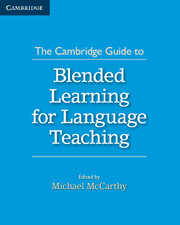Introduction: Blended Learning
Published online by Cambridge University Press: 22 September 2021
Summary
For centuries teachers the world over have sought to provide the conditions in which their learners can learn. Opinions and practices may differ; what constitutes ‘good’ conditions and effective learning has long been a matter for lengthy discussion and debate. Today, with the rapid development in the use of technology in our everyday lives and increasingly in teaching and learning, the debate continues to be long and protracted. This said, there is some agreement that technology and globalisation have changed the way people – especially young people – think and learn. There is also agreement that technology does, and indeed should, have a role to play in learning and teaching. However, there are some who see technology as the only solution to all current educational problems, while there are others who are completely opposed to this view and see technology as the major threat to civilisation as we know it and an agent of the ‘dumbing-down’ of quality education.
This book is about blended learning, and attempts to place the use of technology in language learning and teaching within a context which we hope reassures the sceptics but at the same time illustrates the benefits. This book also aims to curb the, at times, overenthusiastic embrace of technology and stresses the need to revisit the pedagogical foundations of our understanding of what it means to learn and teach a language.
In a sense, various blends of ways of learning languages have existed side-by-side for a very long time. Learners and teachers look for the best conditions in which to foster learning. Ever since the first student carried around a notebook and continued working outside of class hours, we have been engaging in blended learning. The notebook, the pen and paper were the technologies which enabled learning to continue outside of class time. The components of the blend were called ‘classwork’ and ‘homework’, and this type of blended learning has served us well for generations. In the mid-twentieth century, new technologies came along which made it possible to extend learning in different ways outside of the classroom. In the 1960s, language laboratories came to the fore, enabling students to practise listening and speaking in the private environment of the laboratory booth, to imitate models and to work at their own pace. This mix of learning modes had much in common with what we now term blended learning.
- Type
- Chapter
- Information
- Publisher: Cambridge University PressPrint publication year: 2015

